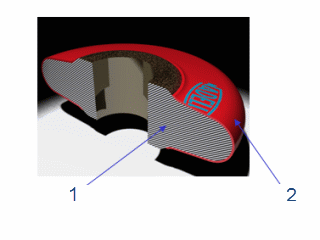Core Materials
A core material ![]() is the constitutive material of an object.
is the constitutive material of an object.
You can use core materials in the following contexts:
| Context | Description |
|---|---|
| Simulation | The Young's modulus and Poisson's ratio specified as part of the material's linear elastic domain are used to compute simulations. |
| Assembly Design | The density specified as part of the material's attributes is used to calculate mass. |
| Rendering | If there is no covering material on top of the core material, the attributes specified as part of the core material's appearance domain are used to display the material. |
| Drafting | The attributes specified as part of the material's drafting domain are used to represent cross-sectional views with the appropriate hatching patterns. |
| Composite | The attributes specified as part of the material's composite domain are used in designing composite parts. |
| Important: You can apply only a single core material to an object. |
